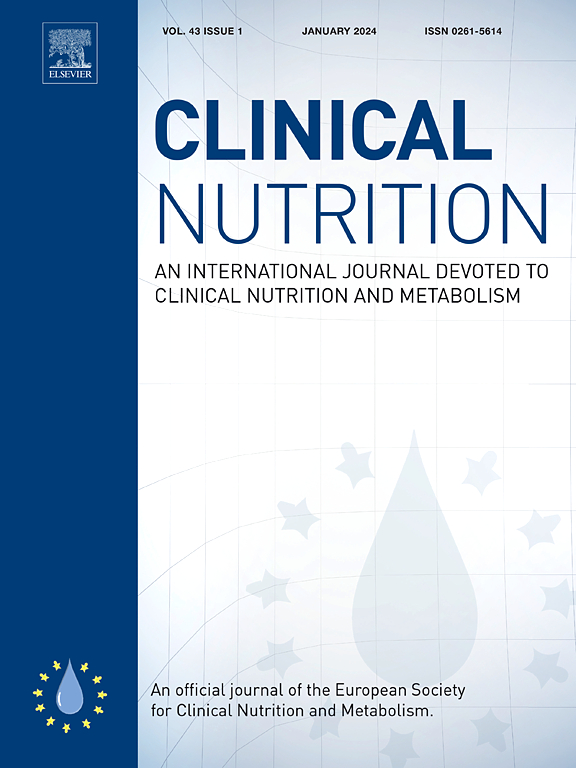味觉和嗅觉与癌症患儿的饮食摄入量、饮食行为、营养状况以及与健康相关的生活质量有关。
IF 6.6
2区 医学
Q1 NUTRITION & DIETETICS
引用次数: 0
摘要
背景和目的:气味和味道的变化是儿童癌症治疗过程中经常出现的令人烦恼的治疗症状,并被认为会影响食物摄入量等结果。由于癌症患儿的营养状况本来就很脆弱,因此应防止对食物摄入造成任何不利影响。因此,了解化疗感官变化与饮食摄入量、饮食行为以及健康相关生活质量(HRQoL)等其他领域之间的确切关系对于改善治疗效果非常重要:在这项纵向研究中,我们对 87 名接受血液、实体或脑部恶性肿瘤治疗的儿童癌症患者进行了跟踪调查。分别使用商业嗅棒和味条及自我报告对嗅觉(气味阈值和气味识别)和味觉功能(味觉总分)进行了客观调查。膳食摄入量采用 3 天食品乳制品进行测量。至于营养状况,则根据医疗记录得出以标准偏差分数表示的体重指数。饮食行为和 HRQoL 分别通过行为儿科喂养评估量表(BPFAS)和 PedsQL 4.0 通用核心量表进行评估。急性淋巴细胞白血病(ALL)患儿的测量时间分别为6周(T0)、3个月(T1)、开始化疗后6个月(T2)以及化疗终止或维持阶段后3个月(T3)。采用混合模型分析法对不同时期的饮食摄入量、饮食行为、营养状况和 HRQoL 进行建模。研究了嗅觉和味觉(客观和自我报告)以及患者特征之间的关联:结果:在研究期间,能量摄入量明显增加,年龄、体重指数和味觉总分也随之增加。与女孩相比,男孩的能量摄入量更高。进食行为得分明显下降,表明进食问题减少。年龄、诊断前的饮食行为、自我报告的气味变化和管饲与饮食行为有关。体重指数(BMI)明显升高,诊断时的体重指数越高,研究期间的体重指数也越高。接受插管喂养和自述味觉改变的儿童的体重指数较低。在研究期间,HRQoL有所改善,而接受管饲和自我报告口味变化的儿童的HRQoL较低:结论:味觉和嗅觉的客观和主观测量都会影响饮食摄入量、饮食行为、营养状况和 HRQoL。为防止化学感官变化对癌症患儿的食物摄入量和临床结果产生不利影响,有必要提供个性化的饮食建议和应对策略。本文章由计算机程序翻译,如有差异,请以英文原文为准。
Taste and smell are associated with dietary intake, eating behavior, nutritional status, and health-related quality of life in children with cancer
Background & aims
Smell and taste changes are frequently reported bothersome treatment symptoms during treatment for childhood cancer and assumed to influence outcomes such as food intake. Since nutritional status of children with cancer is already vulnerable, any detrimental effects on food intake should be prevented. Therefore, understanding the exact relationship between chemosensory changes and dietary intake, eating behavior, and other domains such as health-related quality of life (HRQoL), is important for improving outcomes.
Methods
In this longitudinal study, we followed 87 childhood cancer patients treated for hematological, solid, or brain malignancies. Smell (odor threshold and odor identification) and taste function (total taste score) were objectively investigated using commercial Sniffin’ Sticks and Taste Strips respectively, and by self-report. Dietary intake was measured using a 3-day food dairy. For nutritional status, BMI expressed as standard deviation scores was derived from medical records. Eating behavior and HRQoL were assessed by the Behavioral Pediatrics Feeding Assessment Scale (BPFAS) and PedsQL 4.0 Generic Core Scales, respectively. Measurements were taken approximately 6 weeks (T0), 3 months (T1), 6 months after starting chemotherapy (T2), and 3 months after termination of chemotherapy or maintenance phase for children with acute lymphoblastic leukemia (ALL) (T3). Dietary intake, eating behavior, nutritional status, and HRQoL were modelled over time using mixed model analysis. Associations between smell and taste (objective and self-report), as well as patient characteries were studied.
Results
Energy intake significantly increased during the study period, with a higher age, BMI, and total taste scores associated to this increase. Boys had higher energy intake compared to girls. Eating behavior scores significantly declined, indicating less eating problems. Age, pre-diagnosis eating behavior, self-reported smell changes, and tube feeding were associated to eating behavior. BMI significantly increased, with a higher BMI at diagnosis to be related to a higher BMI during the study period. A lower BMI was found in children receiving tube feeding and self-reported taste changes. HRQoL improved during the study period, with lower HRQoL in children receiving tube feeding and self-reported taste changes.
Conclusion
Both objective and subjective measures of taste and smell influence dietary intake, eating behavior, nutritional status, and HRQoL. Individual dietary advice and coping strategies are warranted to prevent detrimental effects of chemosensory changes on food intake and clinical outcomes in children with cancer.
求助全文
通过发布文献求助,成功后即可免费获取论文全文。
去求助
来源期刊

Clinical nutrition
医学-营养学
CiteScore
14.10
自引率
6.30%
发文量
356
审稿时长
28 days
期刊介绍:
Clinical Nutrition, the official journal of ESPEN, The European Society for Clinical Nutrition and Metabolism, is an international journal providing essential scientific information on nutritional and metabolic care and the relationship between nutrition and disease both in the setting of basic science and clinical practice. Published bi-monthly, each issue combines original articles and reviews providing an invaluable reference for any specialist concerned with these fields.
 求助内容:
求助内容: 应助结果提醒方式:
应助结果提醒方式:


